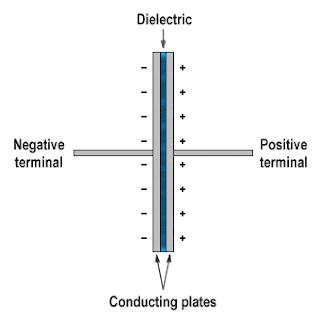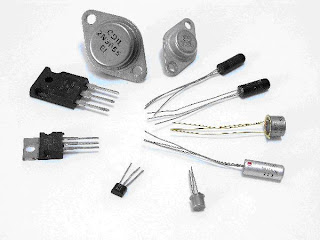Inductance is a
property in an electronic circuit where a change in current in a
circuit creates a voltage in the circuit itself and also the
nearby circuits. A steady stream of current in a conductor creates
a magnetic field around the conductor. A varying magnetic field
in a circuit induces a voltage in an adjacent conductor. An
inductor is a passive electrical component that stores energy in
its magnetic field. Inductance is created from the magnetic field
that is formed around a conductor which carries current that tends to oppose the change in current.
Photo credit: softwareforeducation.com
Inductor Property
All conductors have inductance and can be made into an inductor. A
length of conductor can become an inductor and the inductance will
be greater when it is wound into a coil. An inductor is usually a
conductor turned into a coil form, which concentrates or increases
the magnetic field of the conductor.
An electric current through a inductor creates a magnetic flux or
magnetic field. A change in the electric current also creates a
change in the magnetic flux which is proportional to the current.
Self Inductance
A
conductor has self inductance where a change in the electric
current through a circuit having inductance induces a proportional
voltage that opposes the change in current. A varying magnetic
field in the coil is needed for inducing an opposing voltage in the
coil. The changing magnetic flux generates an electromotive force
that opposes the change in current. This changing magnetic flux
induces a voltage in the coil. This voltage tend to oppose the
change and will try to decrease the current if it is increasing or
increase the current if it is decreasing. This opposing flow of
electric current is termed as self induction. Self
inductance can be illustrated using an experiment. Here a battery
is connected through a switch across a coil wound many times on an
iron core. A small lamp that lights on battery voltage is connected
across the terminals of the coil. An ammeter is connected in series
to the coil and the switch. When
the switch is opened, the ammeter reading falls to zero but the lamp
flashes very brightly and goes out.
Photo credit: electronicsbasics1.blogspot.com
Mutual Inductance
Mutual
inductance happen when the coils are kept near so that the magnetic
flux from one inductor cross to the other and thus they exhibit
mutual inductance. It is the phenomenon of production of induced
current in one coil by changing the magnetic flux due to current in
another coil. The varying current in
the coil or circuit induces a voltage in an adjacent coil or
circuit is called as mutual inductance. Mutual inductance between
coils depends upon their coefficient of coupling, which can vary
from 0 to 1.
Factors Affecting Inductance
The inductance of an inductor depends on
1. The number of loops of the coil. The larger the number of turns the greater is the inductance.
2. The size of each loop. The greater the size of the loop, the greater is the inductance.
3. The permeability of the material used as the former to wind the
coil. The magnetic flux can be increased by coiling the conductor
around a material with high permeability. Materials with high
permeability includes soft iron, ferrite, etc.
4. Cross section of the core. The larger the cross section of the core, the higher the inductance.
5. Spacing of the turns. The smaller the spacing between the turns of the coil the greater is the inductance.
Photo credit: hyperphysics.phy-astr.gsu.edu
The unit of measurement of inductance is the henry and the symbol for inductance is L
An
inductor of 1 henry of inductance produces an EMF of 1 volt when
the current through the inductor changes at the rate of 1 ampere
per second. Henry is a large unit and smaller units are usually used
in practice especially in radio, where millihendry mH or microhenry microH are used.
The relationship between self inductance L, voltage, and current in a circuit is
V = L * di/dt
Where
V is the voltage in volts, L is the self inductance, i is the
current in amperes, and t is the time. The voltage across the
inductor is proportional to the product of its inductance and the
time rate of change of the current through it.
Inductance
is present in almost all circuits which may have beneficial or
detrimental effects to the function of the circuit. Inductors can
be used where the current and voltage changes with time. Inductors
have the ability to delay and shape alternating currents. Common
inductors consists of a specific number of turns of enamelled copper wire, wound around a former such as air, iron, laminated steel, ferrite, Teflon etc.
Photo credit: electrocircuitschema.blogspot.com
An
ideal inductance has inductance but no resistance or capacitance and
does not dissipate or radiate energy. However real inductance have
resistances due to the resistance of the wire and the parasitic
capacitances due to electric field between the turns of the coil
having slightly different potentials. Energy is dissipated by the
resistance of the wire and by the losses of the magnetic core due to
hysteresis.
Uses and Effects of Inductance
Inductances
are widely used in radio circuits, other analog circuits, and signal
processing. Inductances provide frequency selection in a tuned circuit
of the radio. Large inductors are used in power supplies to filter
out mains hum, power supply noises,
and fluctuations in the DC. Inductors are used in filter circuits
to filter out waveforms or in energy storage systems. Audio chokes
have many turns of wire on iron core, which has inductances of 1 to
100 henrys. Radio frequency chokes have inductances of a few turns
of wire wound on a nonmagnetic core. Power transformers are used in
power supplies for most electronic equipments. Coupled magnetic
fluxes between a stationary and a rotating inductor coil is used to
produce mechanical torque in induction motors. Inductors are used as
an energy storage device in switch-mode power supplies. Variable
inductors use an adjustable core, which is usually a ferrite core or
powdered iron core, that can change the inductance.
Inductances
are found in transmission cables that determine the characteristic
impedance in a cable. Inductances are also seen in microphone and
computer network cables that use special cables to reduce it. Long
power transmission lines also shows inductances which limits the AC
power that can be sent through them.
Photo credit: emailschool.com
Types of Inductances
There are 2 types of inductors, fixed inductor and the variable inductor.
Fixed
inductors are air core inductor, radio frequency inductor,
ferromagnetic core inductor, laminated core inductor, ferrite-core
inductor, and toroidal core inductor.
Variable
inductors are widely used in radio applications to set a definite
oscillating frequency and to tune the resonant circuits. These may
include many different types of slug tuned inductors. Slug tuned
inductors are widely used in RF and IF stages of super heterodyne radio receivers. Tuned inductors are also used as the tank coil in the final RF power amplifiers.



















